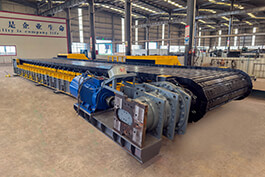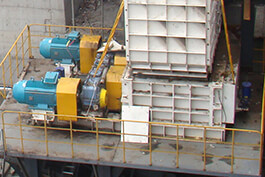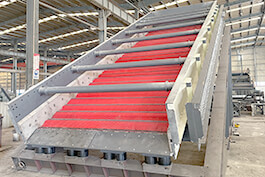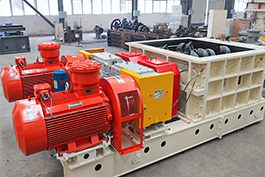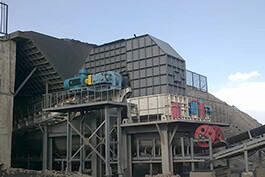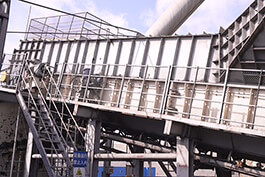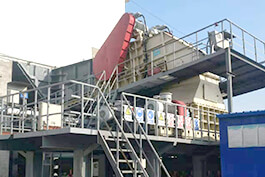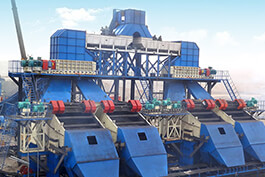Introduce
The lubrication system in a mineral sizer, a heavy-duty machine used in mining and mineral processing to crush and size materials, is critical for ensuring smooth operation, reducing wear, and extending equipment lifespan.
Typically, mineral sizers employ a centralized automatic lubrication system to deliver precise amounts of lubricant to critical components like bearings, gears, and other moving parts.
System Components of the Mineral sizer Lubrication System
Time Controller
Function: The time controller is used to automatically control the working cycle of the lubrication system. It starts and stops the lubrication pump or automatic lubrication device at the set time intervals to ensure that each lubrication point of mineral sizer is lubricated at the correct time. The time controller can preset the lubrication cycle to adapt to different equipment operating conditions.
Function: By controlling the supply frequency of the lubricant at regular intervals, the accuracy of lubrication and work efficiency can be improved, and over-lubrication or insufficient lubrication can be avoided.
Grease/Oil Pump
Function: The lubricating oil/grease pump is the core component of the centralized lubrication system, responsible for drawing lubricants (oil or grease) from the oil or grease depot and transporting them through pipelines to various lubrication points.
Type:
Oil pump: Used in oil lubrication systems, it can provide high flow and pressure, and is suitable for high-speed and heavy-load equipment.
Grease pump: Used in grease lubrication systems, it is suitable for applications with light loads and low speeds.
Pressure Regulating Valve
Function: The pressure regulating valve is used to control the oil pressure or grease pressure in the lubrication system, ensuring that the lubricant is supplied to the lubrication points at an appropriate pressure. If the pressure in the system is too high or too low, the regulating valve will automatically adjust the pressure to prevent damage to the mineral sizer or insufficient lubrication caused by excessive pressure.
Function: Maintain a stable pressure within the system, ensure uniform flow of the lubricant, and prevent poor lubrication or leakage caused by improper pressure.
Automatic Lubricators
Function: The automatic lubricator is one of the key components in the centralized lubrication system, responsible for providing lubricant to each lubrication point at the predetermined time and flow rate. They are usually equipped with sensors and timers to automatically perform lubrication operations, reducing manual intervention.
Type:
Quantitative automatic lubricator: Provides a certain amount of lubricant to each lubrication point according to the set flow rate.
On-demand automatic lubricator: Automatically adjusts the supply quantity and cycle of the lubricant according to the actual operating status.
Oil Filling Pipeline
Function: Oil filling pipes are used to transport lubricating oil or grease from the oil depot to the lubrication system. It connects the lubricating oil depot and the lubricating pump and serves as the channel for lubricants to enter the system.
Features: The pipes need to have properties such as high pressure resistance and corrosion resistance to adapt to the high-pressure and harsh working environment during the high-load operation of mineral sizer.
Reservoir
Function: The lubricating oil reservoir or grease reservoir is a storage container for lubricants in a centralized lubrication system. It provides sufficient lubricant to supply each lubrication point in the system. The capacity and type of the oil depot depend on the scale of the lubrication system and the working requirements of the equipment.
Feature: The oil depot needs to be well sealed to prevent the leakage and contamination of lubricants. It also needs to be equipped with a cleaning and filtering device to prevent contaminants from entering the system.
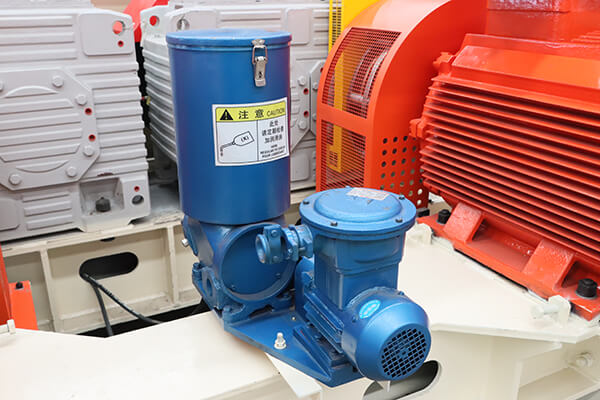
The Working Process of the Mineral Sizer Lubrication System
Initial preparation and lubricant supply
Before the centralized lubrication system starts to operate, the lubricating oil or grease reservoir will be filled with sufficient lubricant according to the working requirements of the Mineral sizer. Oil depots are usually equipped with oil level sensors to ensure that there is an adequate amount of lubricant and to prevent the system from failing due to insufficient oil.
Lubricating oil or grease is transported from the oil depot to the lubrication pump through the filling pipeline. The design of the filling pipeline for lubricants must ensure a stable flow rate to prevent pipeline blockage or oil leakage.
Time control and lubrication pump startup
When the mineral sizer starts up, the time controller begins to work according to the set cycle. It controls the start and stop of the lubrication pump to ensure that the lubricant is supplied on time.
Control the periodic start of the lubrication pump by setting the time interval. The cycle is usually adjusted according to the working load and lubrication requirements of the mineral sizer to avoid over-lubrication or under-lubrication.
After the time controller is started, the lubrication pump begins to transport lubricating oil or grease from the oil depot to each lubrication point of the system. Lubrication pumps are usually high-pressure pumps or high-flow pumps, suitable for the high-load and complex working environment of mineral sizer.
Lubricant distribution and supply at lubrication points
Driven by the lubrication pump, the automatic lubricator is responsible for providing lubricant to various lubrication points in the mineral sizer, such as gear roller bearings, gears, etc. The automatic lubricator can control the flow rate and supply frequency of the lubricant according to the requirements of the lubrication points.
Each lubrication point precisely acquires the required amount of lubricant through a distributor to ensure that the lubricant is sufficient but not excessive. This can prevent excessive lubrication and reduce the waste of lubricating oil.
The system automatically adjusts the lubrication frequency based on the working status of the Mineral sizer (such as load, operating speed, etc.) to ensure that more lubricant is provided at high loads and less at low loads.
Pressure regulation and lubrication pressure control
In the system, lubricating oil is precisely controlled through a pressure regulating valve. The valve will automatically adjust the pressure of the lubricant according to the output pressure of the lubrication pump to ensure that the pressure is moderate and prevent excessive pressure from damaging the lubrication components of mineral sizer.
When the pressure in the lubrication system is too high, the pressure regulating valve will automatically reduce the pressure to prevent the lubricant from flowing too quickly, which may cause waste or oil overflow.
If the lubrication pressure is too low, the valve will automatically adjust to increase the pressure to ensure that the lubricant can fully reach all lubrication points, especially key components such as gear roller bearings.
The transportation and flow of lubricants
Lubricants are delivered to each lubrication point of Mineral sizer through pressure-resistant oil pipelines, ensuring that the lubricating oil or grease can flow stably to each component. The pipeline system is rationally designed to ensure that the lubricant will not leak or be lost, maximizing the utilization of every drop of lubricant.
The pipeline sealing design should be reliable to prevent the leakage of lubricants, which could contaminate the working environment and reduce the lubrication effect.
Return the pipeline and waste lubricating oil treatment
After the lubricant has been used, especially in oil lubrication systems, the used lubricating oil is returned to the oil depot through the return pipeline for reprocessing or recycling. The return pipe also helps to clean the oil that has lost its lubricating effect and ensures the continuous and efficient operation of the system.
The return oil is usually cleaned through a filtration device to remove contaminants and ensure that the reused lubricating oil still maintains good lubricating performance.
Lubrication status monitoring and alarm system
In the centralized lubrication system of Mineral sizer, monitoring the oil level and oil temperature is of great significance. When the oil level is too low, the system will automatically sound an alarm to remind the operator to add lubricant. When the temperature is too high, an alarm will also be triggered to prevent the lubricating oil from overheating and affecting the lubrication effect.
The system will be equipped with sensors to monitor the oil level and temperature, providing real-time feedback to help maintenance personnel take timely measures and ensure that the lubrication system of Mineral sizer is always in the best working condition.
Advantages of Centralized Automatic Lubrication
Improve operational efficiency
As the lubrication system is automated, operators do not need to frequently manually add lubricants to the mineral sizer, saving a significant amount of time and labor costs. The lubrication cycle and lubrication volume are adjusted according to the actual needs of the equipment to ensure the maximization of lubrication effect.
Reduce wear and tear
Precise lubrication: The centralized lubrication system can ensure that each lubrication point is precisely lubricated, avoiding over-lubrication or under-lubrication, significantly reducing the wear of components such as gear roller bearings and gears, and extending the service life of mineral sizer.
Reduce failure rate: Regular and uniform lubrication can effectively lower the damage rate of toothed roller bearings and other key components, thereby reducing downtime and maintenance costs.
Enhance safety
Automatic lubrication reduces the frequency of operators' contact with mineral sizer, especially in high-temperature, high-pressure or dusty environments, thereby reducing the safety risks to workers.
Through automated control, the lubrication system can precisely monitor the lubrication status, reducing the possibility of human negligence and ensuring the long-term stable operation of mineral sizer.
Easy to maintain
The centralized lubrication system simplifies the lubrication management of mineral sizer. Operators can monitor the operation of the entire system through a central control panel, promptly identifying and resolving lubrication issues.
The system is usually equipped with a fault alarm function, such as low lubricating oil level or insufficient pressure, which makes the prevention and handling of faults more timely.
Reduce pollution and waste
Save lubricants: Centralized lubrication systems can precisely control the amount of lubricants allocated, avoiding over-lubrication and waste of lubricants.
Reduce external pollution: Excessive lubricants may leak into the environment, causing pollution. The centralized lubrication system reduces the leakage and waste of lubricants through precise control of the lubrication volume.
Conclusion
The application of centralized lubrication systems in mineral sizer has significantly enhanced the lubrication effect of the equipment, ensuring the normal operation of key components such as gear roller bearings, extending the service life of the equipment, and reducing manual operation through automated lubrication methods, thereby improving work efficiency.
By measures such as reducing malfunctions, minimizing wear and tear, and lowering temperatures, the centralized lubrication system not only enhances the performance of the equipment but also significantly reduces the maintenance costs for long-term operation.



